
The Arecaceae is a family of perennial, flowering plants in the monocot order Arecales. Their growth form can be climbers, shrubs, tree-like and stemless plants, all commonly known as palms. Those having a tree-like form are called palm trees. Currently, 181 genera with around 2,600 species are known, most of which are restricted to tropical and subtropical climates. Most palms are distinguished by their large, compound, evergreen leaves, known as fronds, arranged at the top of an unbranched stem. However, palms exhibit an enormous diversity in physical characteristics and inhabit nearly every type of habitat within their range, from rainforests to deserts.
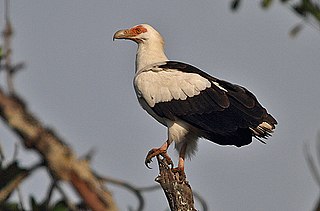
The palm-nut vulture or vulturine fish eagle, is a large bird of prey in the family Accipitridae. It is the only member of the genus Gypohierax.
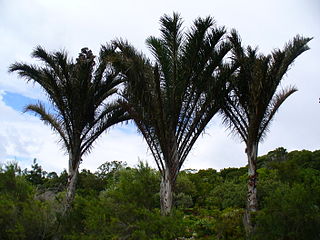
Raffia palms (Raphia) are a genus of about twenty species of palms native to tropical regions of Africa, and especially Madagascar, with one species also occurring in Central and South America. R. taedigera is the source of raffia fibers, which are the veins of the leaves, and this species produces a fruit called "brazilia pods", "uxi nuts" or "uxi pods".
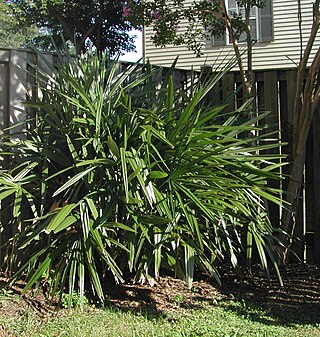
Rhapidophyllum hystrix, the needle palm, is a palm native to coastal margins of the subtropical eastern Gulf and south Atlantic states of the United States. Populations can be found from coastal southeast South Carolina, southward to Florida and west across the coastal plain of Mississippi and southern Alabama. It is one of the most cold-hardy palms in the world, and can be found growing in several areas with warm temperate climates.

Phoenix roebelenii, with common names of dwarf date palm, pygmy date palm, miniature date palm or robellini palm, is a species of date palm native to southeastern Asia, from southwestern China, northern Laos and northern Vietnam,.

The Ouémé River, also known as the Weme River, is a river in Benin. It rises in the Atakora Mountains, and is about 510 kilometres (320 mi) long. It flows past the towns of Carnotville and Ouémé to a large delta on the Gulf of Guinea near the seaport city of Cotonou. The largest tributaries are the Okpara River and the Alpouro River.
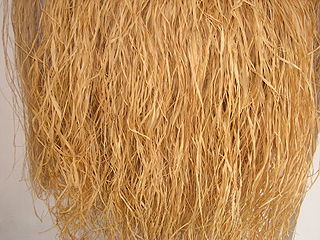
Raphia vinifera, the West African piassava palm, bamboo palm or West African bass fibre is a palm tree species in the genus Raphia. It is native to Benin, Gambia, Ghana, Nigeria, Togo, Central African Republic, Cameroon, Ghana, and Democratic Republic of the Congo. It is particularly abundant along the creeks of Niger Delta, Cross River, Lagos and Ikorodu in Nigeria.

Raphia australis, the giant palm or rafia, is a species of raffia palm in the family Arecaceae. It is found around Kosi Bay in southern Mozambique and northeastern KwaZulu Natal in South Africa. It is threatened by habitat loss caused by drainage of its habitat for agriculture; it is being threatened in the Bobole Special Reserve but is more secure in the Kosi Bay area.

Sabal etonia, commonly known as the scrub palmetto is a species of palm. It is endemic to Florida in the United States, where it is found in Florida sand pine scrub communities.

Sabal mauritiiformis is a species of palm which is ranges from Mexico, Central America, Colombia, Venezuela and Trinidad.

Beccariophoenix alfredii, also known as the high plateau coconut palm, is a recently discovered species of Arecaceae (palms), endemic to Madagascar. It is in the genus Beccariophoenix, and is closely related to the genus Cocos. Beccariophoenix alfredii is very similar in appearance to the coconut palm, although somewhat cold hardy, making it a good look-alike for the coconut in cooler climates.

Calamoideae is a subfamily of flowering plant in the palm family found throughout Central America, South America, Africa, India, China, Southeast Asia and Australia. It is represented by 21 genera - containing nearly a quarter of all species in the palm family - including the largest genus, Calamus, the type genus of the group. Only four are found in the New World while the rest are Old World denizens, usually found in equatorial swampland or along tropical coastlines.
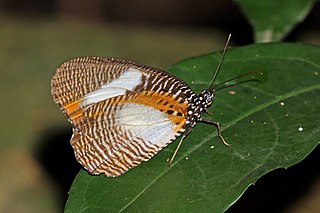
Elymniopsis is a monotypic butterfly genus in the family Nymphalidae. It contains only one species, Elymniopsis bammakoo, the African palmfly.
The Palm Aphid,, is an aphid in the superfamily Aphidoidea in the order Hemiptera. It is a true bug and sucks sap from plants.

Hyphaene coriacea, the lala palm or ilala palm is a species of palm tree native to the eastern Afrotropics. It occurs in eastern Africa from Somalia to Kwazulu-Natal, South Africa, and is also found in the coastal flats of Madagascar and on Juan de Nova Island in the Mozambique Channel Islands.

Raphia farinifera is a tropical African palm tree occurring in lowland riparian and swamp forest, also around human habitations and cultivated locations, on stream banks and other moist situations at altitudes of 50–1000 m. Found in Angola, Benin, Burkina, Cameroon, Gambia, Ghana, Guinea, Ivory Coast, Kenya, Madagascar, Malawi, Mauritius, Mozambique, Nigeria, Réunion, Senegal, Seychelles, Sierra Leone, Tanzania, Togo, Uganda, Zambia and Zimbabwe, and naturalised in Madagascar. Its generic epithet is derived from raphis = 'needle', probably in reference to the 4 mm long yellowish spines on the margins and main veins of the leaflets. The specific name refers to a type of starchy flour obtained from the trunk pith – farina = 'starch', fera = 'bearing'.

The Yewa River is a trans-boundary river between Republic of Benin and Nigeria, running along the Bight of Benin; at one point it crosses the border between the two countries. Other variants of the name are Yeoua, and, with accents, Yéoua and Yéwa. Its elevation is sea level. The Yewa's major sources are the Atan and Ilaro rivers. The Yewa empties into Badagry Creek which empties, in turn, into Lagos Harbor.

Raphia taedigera is a palm species in the family Arecaceae, colloquially known as yolilla in Central American Spanish. It is found in parts of Western Africa, Central America and South America.

Raphia sudanica is a palm species in the family Arecaceae. It is found in Western Africa, where it is locally used for construction purposes.
Lepidocaryeae is a tribe of plants in the family Arecaceae. Subtribes and genera in the tribe are:
















